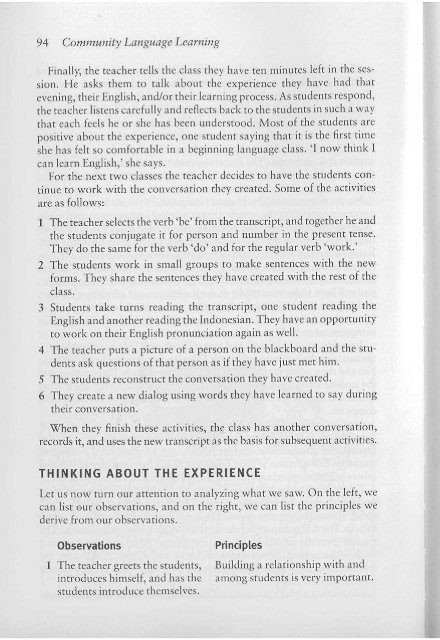Diane Larsen-Freeman
larsen-freeman-techniques-and-principles-in-language-teaching
larsen-freeman-techniques-and-principles-in-language-teaching
- No tags were found...
You also want an ePaper? Increase the reach of your titles
YUMPU automatically turns print PDFs into web optimized ePapers that Google loves.
94 Comr nuniry Langu age Learning<br />
COf1UllIl1Iit)' Langu age Learning 95<br />
f inall y, the teacher tells the class they have ten minutes left in the session.<br />
lie asks them to talk about the experience they have had that<br />
evening, their English, and/o r their learning process. As students respond ,<br />
the teacher listens carefullyand reflec ts hack to the stude nts in such a way<br />
that each feels he or she has been understood. Most of the students arc<br />
posit ive about the experience, one student saying that it is the first time<br />
she has felt so com fortable in a beginning language class. ' I now think 1<br />
can learn English,' she says.<br />
for the next two classes the teacher decides to have the stude nts continue<br />
to work with the conversation they crea ted. Some of the act ivities<br />
arc as follows:<br />
1 The teacher selects the verb 'be' from the transcript, and toget her he and<br />
the students conjugate it for person and number in the present tense.<br />
They do the same for the verb 'do' and for the regular verb 'work.'<br />
2 The students wo rk in small groups to make sentences \vith the new<br />
forms . They share the sentences they have created with the rest of the<br />
class.<br />
3 Students take turns reading the transcript. one student read ing the<br />
English and another readi ng the Indonesian.They have an oppo rtunity<br />
to wor k on their English pro nunciation aga in as well.<br />
4 The teacher puts a picture of a person on the blackboard and the students<br />
ask questions of that person as if they have just met him.<br />
5 The students reconstruct the con versation they have crea ted.<br />
6 They create a new dialog using word s they have learned to say du ring<br />
their conversa tion,<br />
When they fi nish these activities, the class has another convers ation,<br />
records it, and uses the new transc ript as the basis for subsequent activities.<br />
THINKING ABOUT THE EXPERIENCE<br />
l.cr us now turn 111lr attention to anal yzing what we saw. On the left, we<br />
can list our observation s, and on the right, we can list the principles we<br />
derive from our observations.<br />
Observations<br />
The teacher greets the students,<br />
introduces himself, and has the<br />
students introdu ce themselves.<br />
Principles<br />
Building a relati onship with and<br />
among students is very impo rtant.<br />
Observations<br />
2 The tea, her tells the students<br />
what they arc going (0 do that<br />
evening. He explains the<br />
procedure of the first act ivity<br />
and sets a time limit,<br />
3 Students have a conve rsation.<br />
4 The teacher stands behind the<br />
students .<br />
5 The teacher translates what<br />
the students want to sa)' in<br />
chunks.<br />
6 The teacher tells them that<br />
they have on ly a few minutes<br />
remaining for the conversation .<br />
7 Students are invited to talk<br />
about how they felt dur ing the<br />
conversa[Ion.<br />
8 The teach er accepts what each<br />
student says.<br />
Principl es<br />
Any new learning experience can<br />
be threatening. When students<br />
have an idea of what will happen<br />
in each activity, they often feel<br />
more secure. People learn nondefensively<br />
when they feel secure.<br />
Language is for communica tion .<br />
The superior know ledge and power<br />
of the teacher can be threatening.<br />
If the teacher does not remain in<br />
the front of the classroom, the<br />
th reat is reduced and the students'<br />
learn ing is facilitated. Also this<br />
fosters interaction among students,<br />
rather tha n from student to teacher,<br />
The teacher shou ld be sensitive to<br />
students' level of confidence and<br />
give them just wha t they need to<br />
he successful.<br />
Stude nts feel more secure when<br />
they know the limits of an activity.<br />
Teacher and students arc whole<br />
persons. Sharing about their<br />
learn ing experience allows<br />
learn ers to ger ro know one<br />
another and to build community.<br />
Guided by the know ledge rhar each<br />
learner is unique, the teacher creates<br />
an acceptin g atmosphere. Lear ners<br />
feel free to lower their defenses<br />
and the learning experience<br />
becomes less th reatening.


